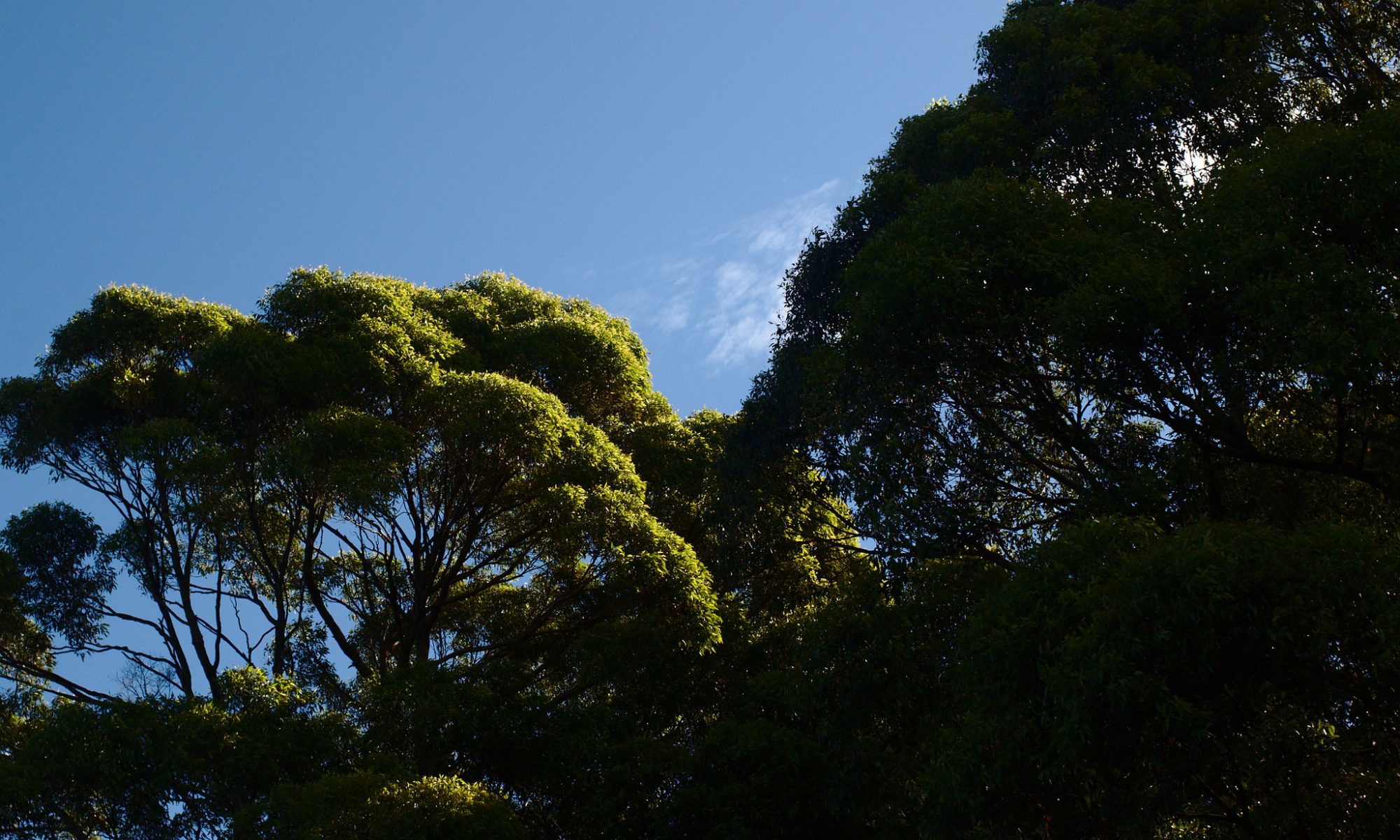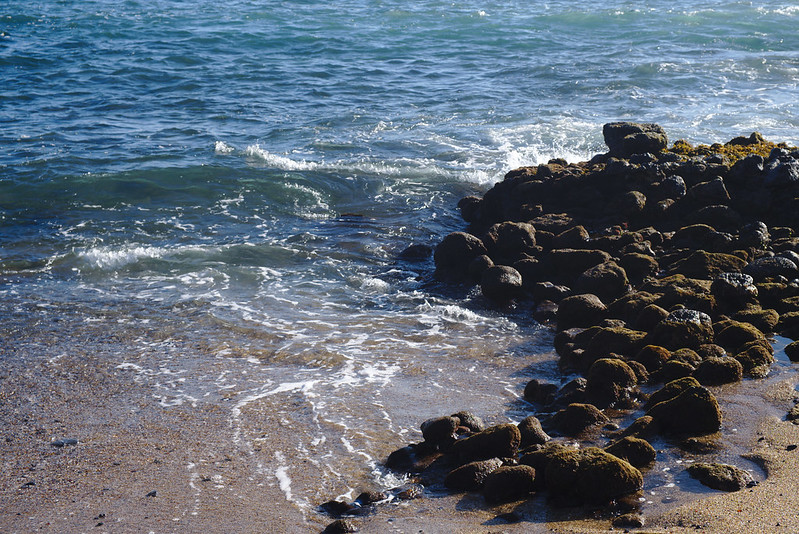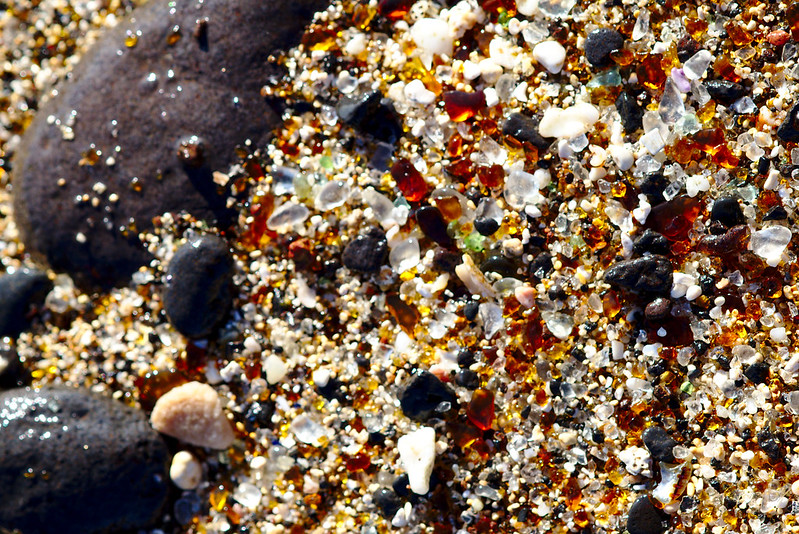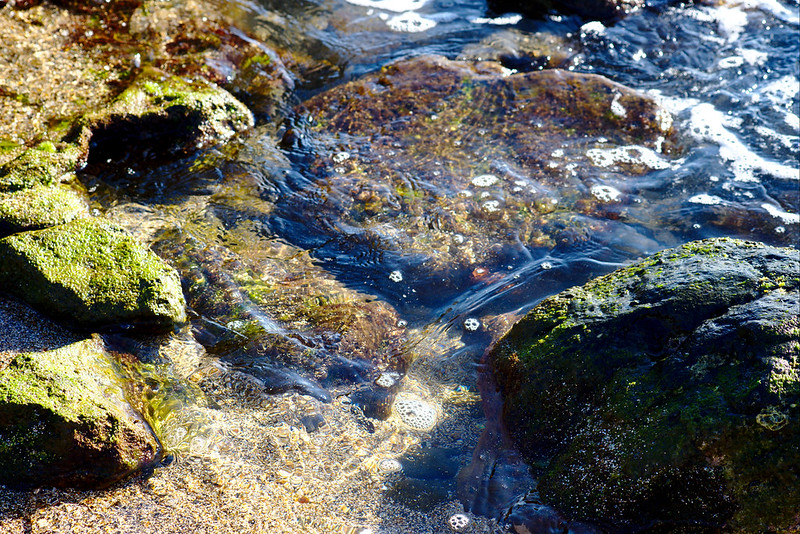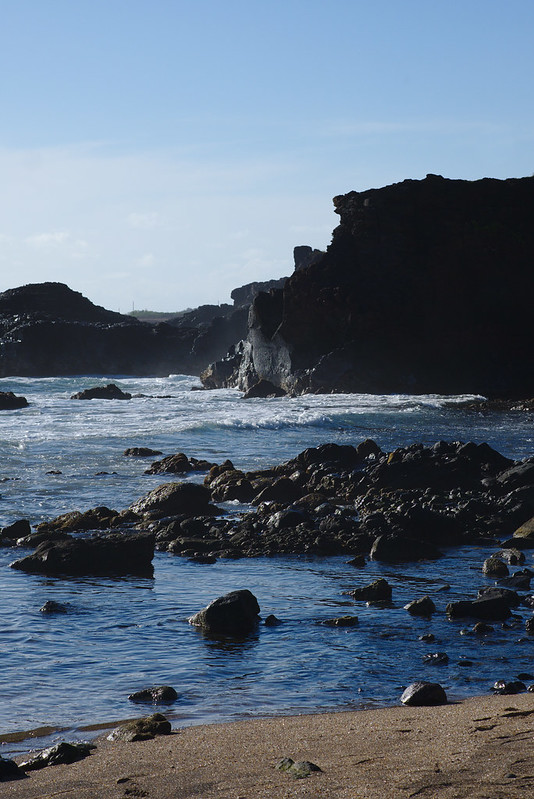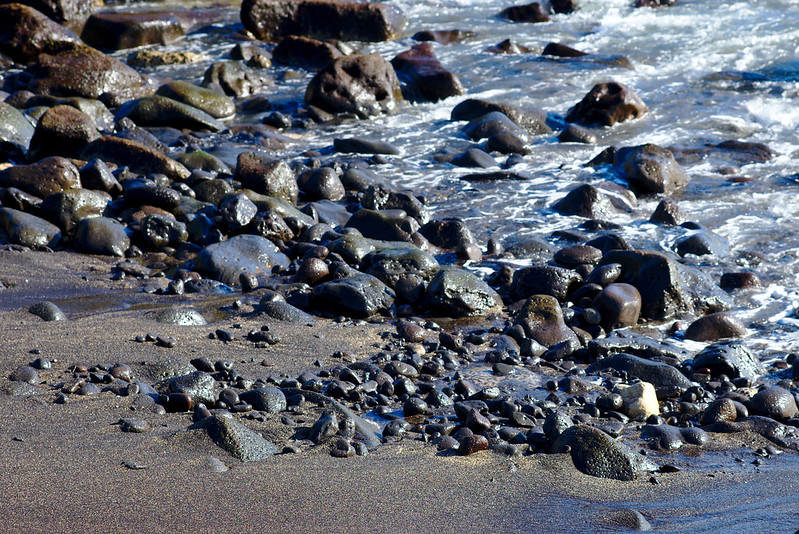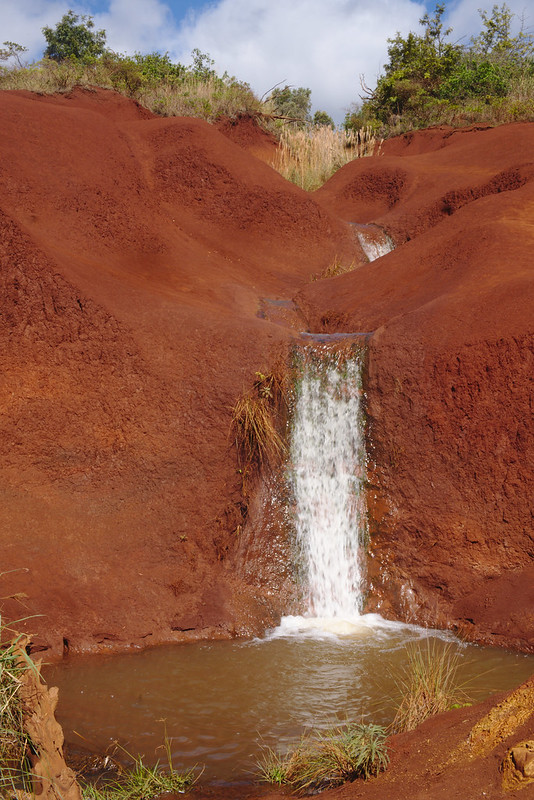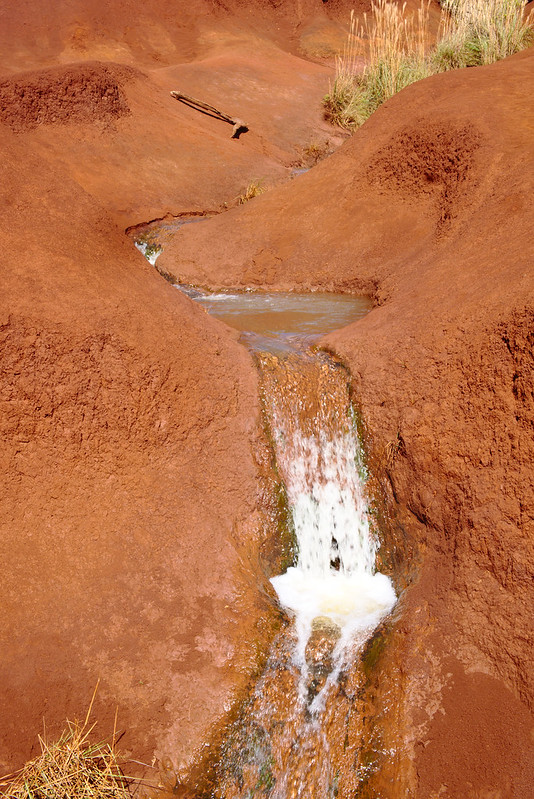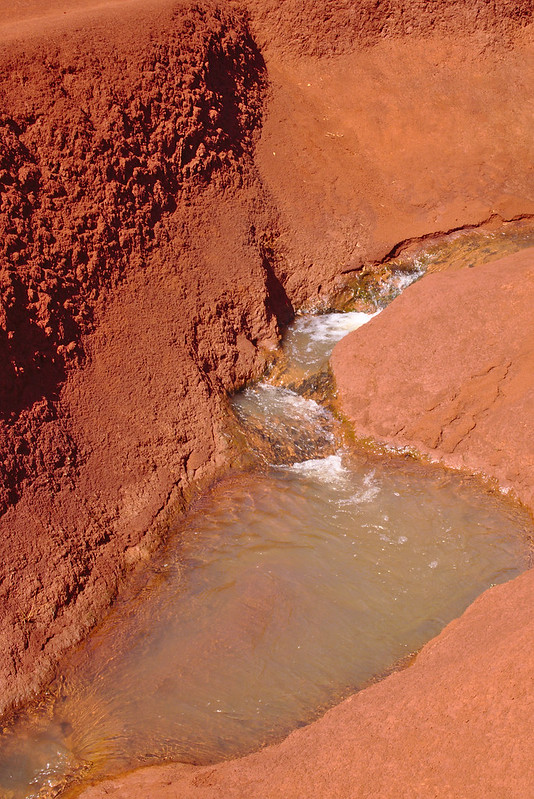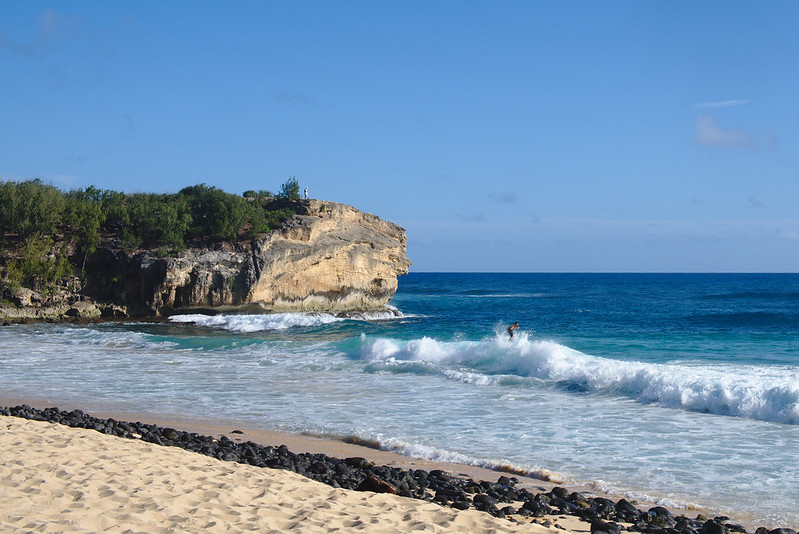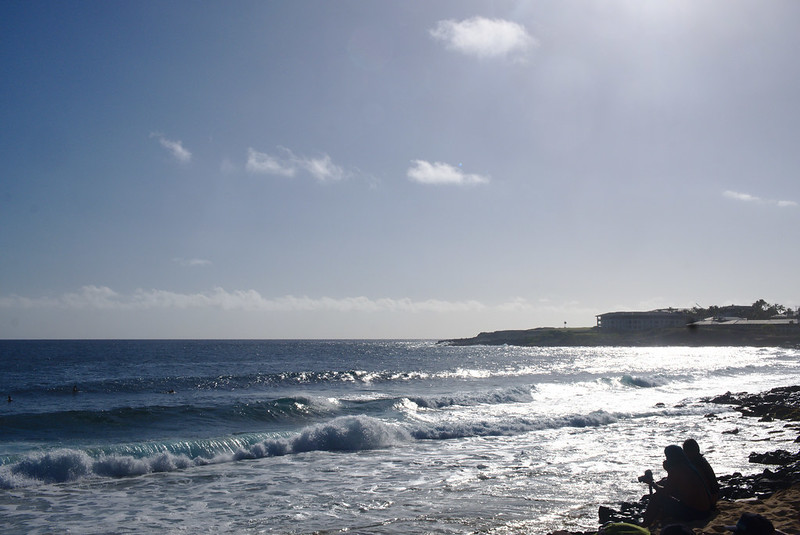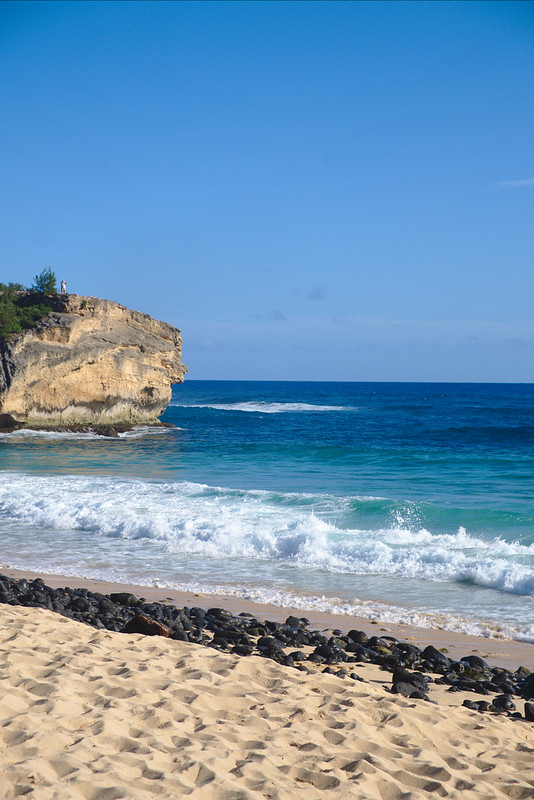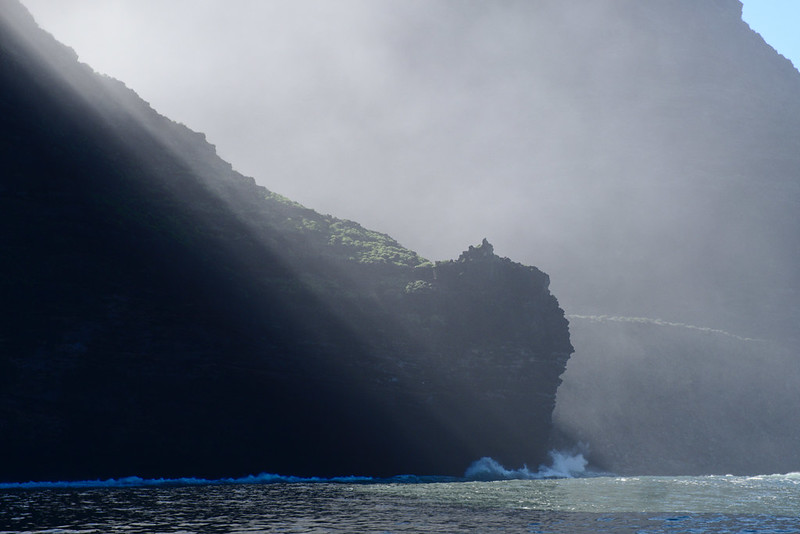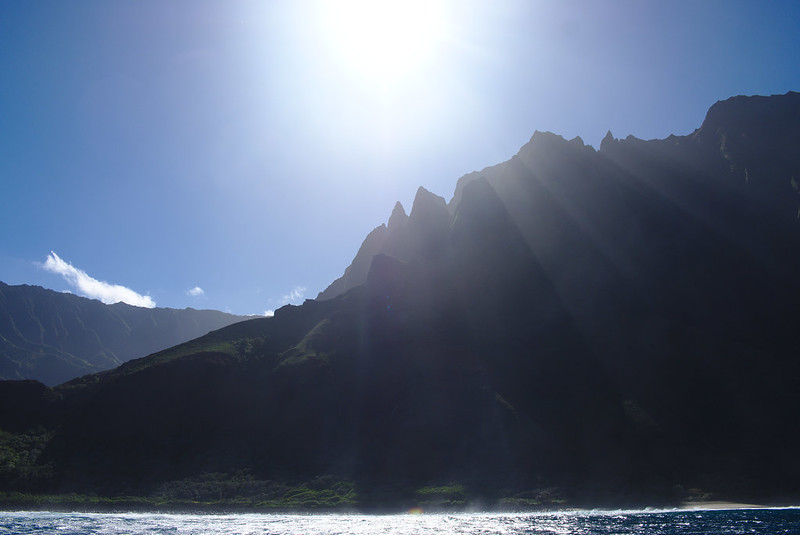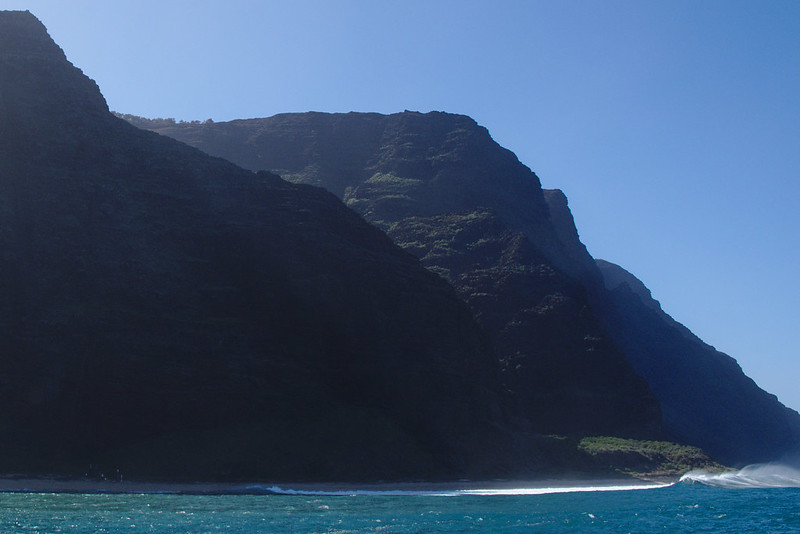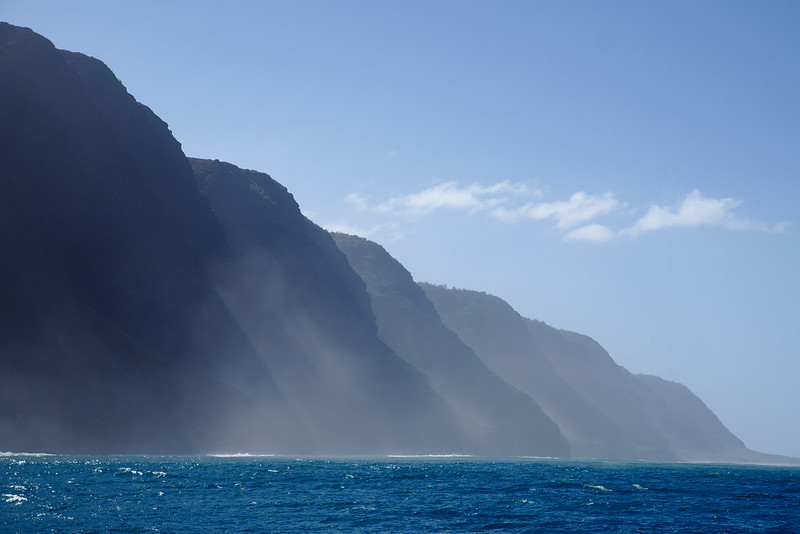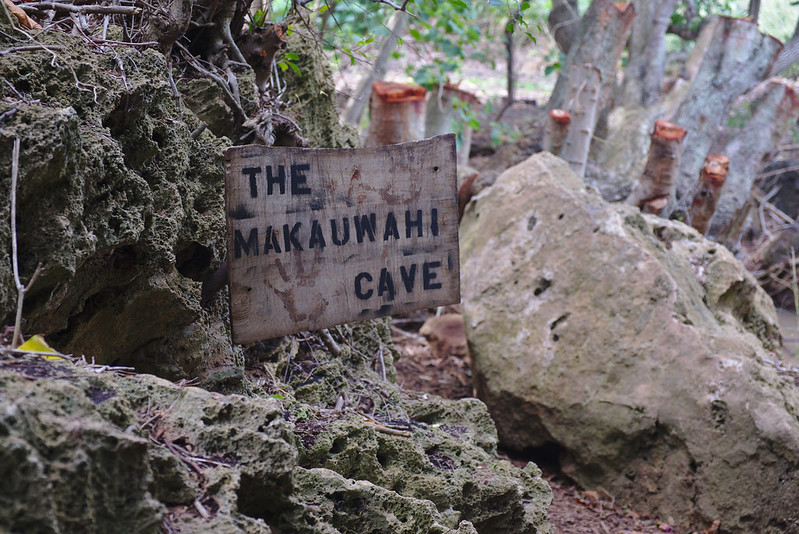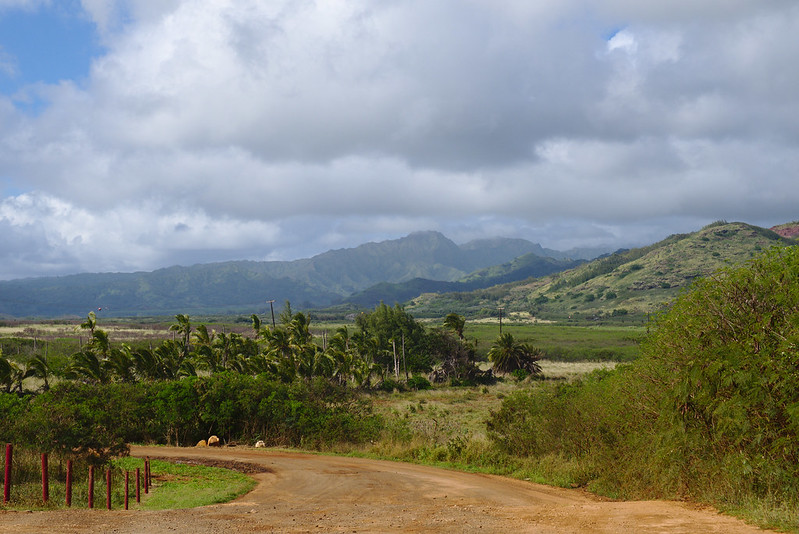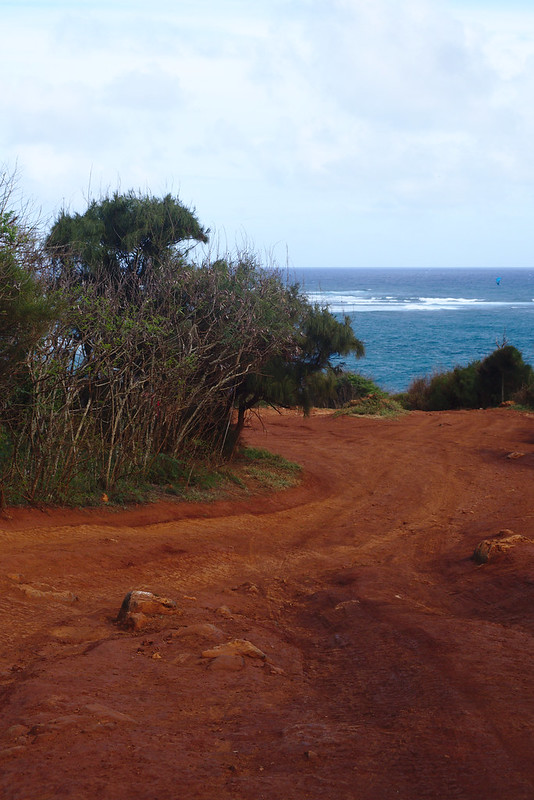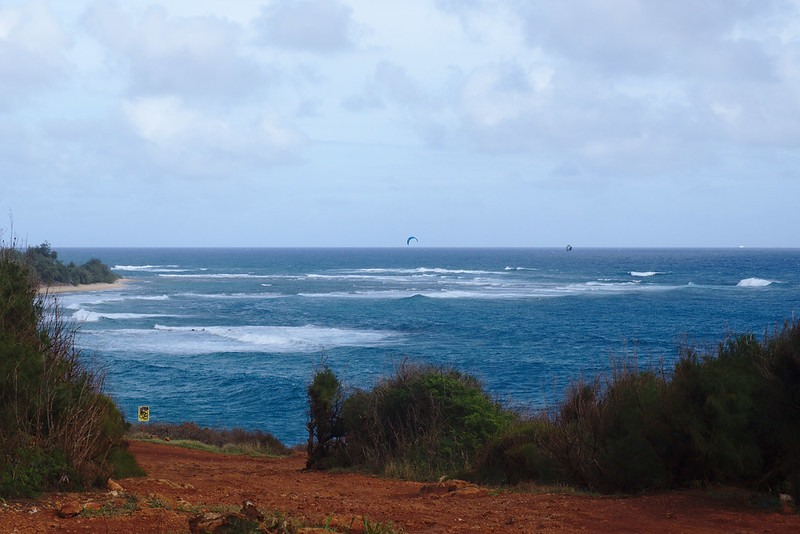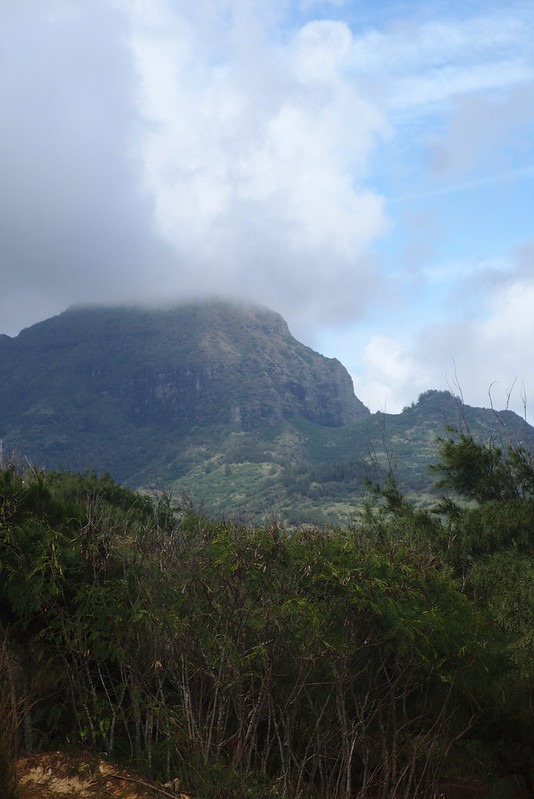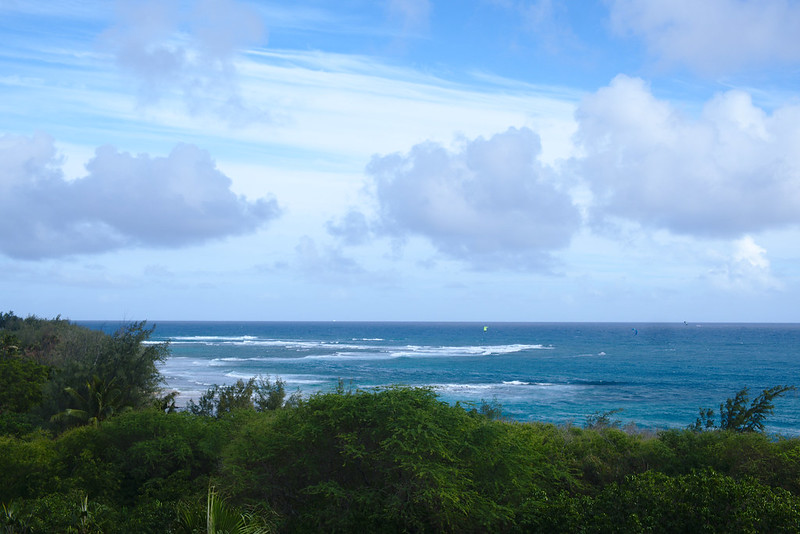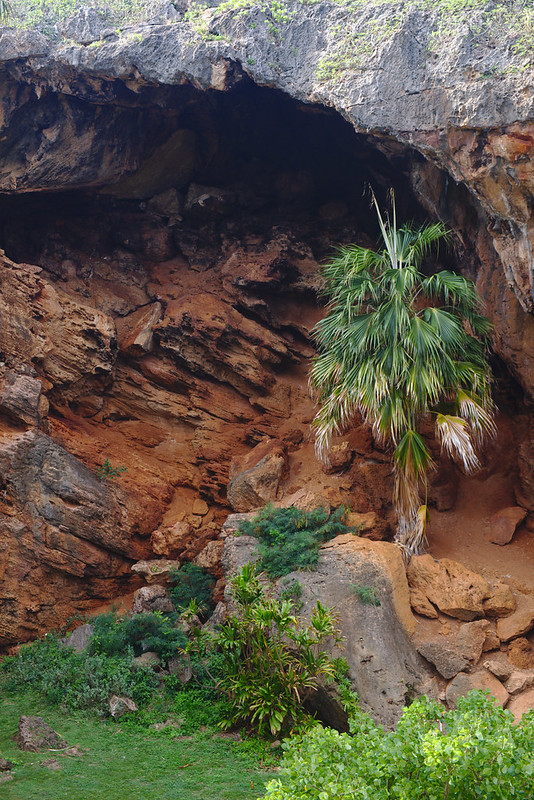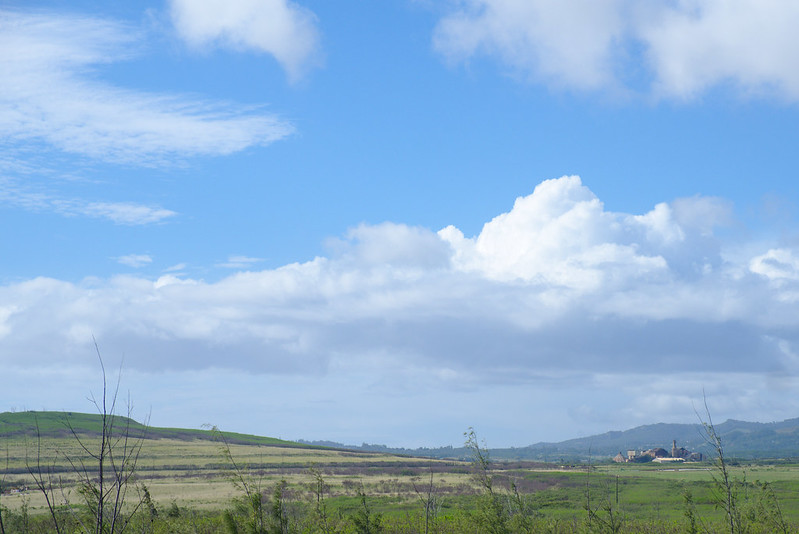Photos of Kauaʻi, January 2018 (in progress).
Red Dirt Falls
When asked for a Waimea Canyon lookout, Google Maps took us to an essentially arbitrary place on Waimea Canyon Drive with perfectly decent views of the canyon, rubbish parking, and a rather scary dropoff. But coming up Waimea Canyon Drive meant that we ran into another essentially arbitrary place with truly terrifying parking: the Red Dirt Falls, about 2km south of the fork with Kokee Road.
Photos of Kauaʻi, January 2018 (in progress).
Shipwreck Beach
For almost all of our trip, Kauaʻi beach safety reports seriously overestimated how dangerous the surf was. Theory: it’s winter, it must be terrible! Practice: my non-swimming four year old is safe and comfortable.
Shipwreck’s Beach was the major exception. It was certainly survivable, particularly past the breakers where not coincidentally most of the swimmers were, but neither of my children swim well enough to penetrate a churning wall of water.
Pretty though!
Photos of Kauaʻi, January 2018 (in progress).
Nā Pali coast in winter
The January winter ocean was rough, the sun was behind the cliffs, and the air was full of sea spray. Breathtakingly difficult to photograph and develop, and yet…
Photos of Kauaʻi, January 2018 (in progress).
The road to Makauwahi Cave
It was slightly too hot for a comfortable walk, everyone was a little tired, the kids were grumpy. They wanted to go down to the beach, we didn’t want to slog back up the hill covered in red dust. And when we got down to the promised cave, it had shut for the day and we all had to turn tail and go home.
You’d think this would be difficult to forgive, but this made it possible:
Photos of Kauaʻi, January 2018 (in progress).
Flickr features I’ve known and loved
As the planning for the sale of Yahoo!/Altaba to Verizon continues, I’m not the only person worried about the fate of Flickr, which has been owned by Yahoo since 2005:
Remember to post a picture of yourself kissing your photos goodbye to Flickr
— Pinboard (@Pinboard) January 10, 2017
I’ve got a tediously backed-up local copy of my photos and won’t have to kiss them goodbye, but as a happy Pro user of Flickr I’m really worried about its future and beginning an active search for replacements. I’m going to start evaluating possible replacements on the basis of these specific features, roughly in order of importance:
My favourite Flickr features
Embedding my foremost use of Flickr is as a photo host for my parenting blog and, increasingly, to show off my best photos. The ability to embed photographs in third-party websites is essential to me.
Locking at the photo level and guest access. It’s not easy to find non-recent photographs of my children on my Flickr account. That’s because I have a script that marks photos as private once they’re a certain age. Some other types of photos (for example, photos of other children) I often mark as private immediately.
Much of my web life runs this way: just because you can find my recent stuff doesn’t mean you get to casually browse everything I’ve done on the Internet since the beginning of time (circa 1999). I’ve taken full advantage of websites with individual locking every time I’ve used one, including WordPress sites, LiveJournal&Dreamwidth, Pinboard, and, yes, Flickr, and strongly prefer it.
At the same time, the chance of people who care about me obtaining a login to Flickr, or to social-photos-site-of-the-month in order to view pictures of a party we were at is basically nil, so the ability to share links to photos via Flickr’s guest pass system has made it useful to me for semi-private events and photos.
API access. I’m not locking all this stuff on all these sites down by hand! It’s all scripted and done via APIs.
Multiple albums for a single photo I look at my photos through several different types of, uh, “lenses”. There’s events, there’s individuals in the photos (mostly my children), and there’s my show-off albums for my favourite photos or ones most I’m likely to want to share with other people if only they’d ask to see more of my photos. I use albums for all three ways of looking at photos, and thus many of my photos are in both a “my kid at age 3” album and a “visit to the beach in November” album.
I also use tags and I might be able to modify my workflow to use tags to replace some of these features, although the result of a tag search would need to be viewable as a first class album, rarely true in my experience so far.
Creative Commons licencing. I like easily dropping my photos into a big pool of photos that might someday find good uses elsewhere and licence a lot of my non-portraits CC BY for (nearly) maximum re-usability. I fear that even sites that support CC licencing won’t end up being searched by anyone in practice, and if I note a CC licence myself in the description, it’s never going to happen.
Features I’d reluctantly sacrifice
Chromecast support. It’s been really enchanting having our TVs display great photos of our kids throughout their lives, travel we’ve done, and a lot of clouds, all via Chromecast’s support for using Flickr photos for background images, but I’m willing to give it up for my core set of features.
An app. Don’t get me wrong, I do like being able to peruse my photos on my phone, but I’d give it up if I had to. Because I do about half my photography with a DSLR, and edit essentially all my photographs, I don’t upload photos via apps in any case.
Less important
The social ecosystem. I started using Flickr regularly after a lot of people stopped, and I’m indifferent to the social features, eg favourites, comments, following other folks, putting my photos in group albums. I do use some of these, but I won’t be looking for them in a replacement.
Locking to different sets of people. I do use Flickr’s “friends” and “family” distinction a little, but in giving up social, I’m also happy to give up locking other than “locked” and “not locked”.
And now, I’m afraid, it’s well and truly time to go shopping for a new photo host. My favourite. Only not.
From comments: this is what a computer scientist looks like
This article originally appeared on Geek Feminism.
From comments on Women in science: contrary to popular belief, some of us are actually alive!, Lindsey has started a Flickr group for “This is what a computer scientist looks like”. The group itself has this description:
This group collects photos of computer scientists, with a particular focus on women (may change later to include other underrepresented groups in CS).
If you are a woman in computer science, feel free to contribute a photo of yourself. If you’re contributing a photo of someone else, please make sure it’s a public photo that you have permission to share, preferably one taken at a public event such as a professional conference or workshop.
In the spirit of Photos of Mathematicians, we’re looking for modern, candid photos of currently active, not-necessarily-famous computer scientists. We’re not looking for historical photos.
So far, I am the only computer scientist. Fear me or displace me at the front of the queue!
Harassing photography and recording; ethics and policies
This article originally appeared on Geek Feminism.
We’re starting to collect some examples of photography/recording harassment experiences (still open , and some of the kinds of problems people mention there and elsewhere are:
- photography/recording conducted in a way that is designed to hide the fact of the photography/recording from the subject both before and after the shot/recording happens
- photography/recording that is indifferent to or careless of the subject’s feelings about being photographed/recorded
- photography/recording that is othering: “wow, women! *click click*” or “hey, babe, smile for the camera!” or later posted with othering, sexist or creepy commentary
- failing or refusing to stop photographing/recording on an explicit request or appearance of discomfort (eg turning away or frowning or covering one’s face, etc)
- publishing photographs without the subject’s consent, or after the subject’s explicit refusal of consent
- use of photographs to implicitly or explicitly endorse an event or community, eg, using pics of smiling participants from the previous year in publicity materials, without consent
Now most of these things are legal in my region (see NSW Photographer’s Rights, which as you will guess from the title is not focussed on subject’s concerns, but which is informative) and in many others. I believe the only exception (in NSW) may be the last, because the use of someone’s image to promote a product requires a model release, that is, consent from the subject. Whether/when using someone’s photo on a website is considered promotion I don’t know but that’s a side point.
For that matter, I’m not even arguing that they should be illegal or actionable (in this piece anyway, perhaps some of them are arguable). I’m sympathetic to many of the uses of non-consensual photography, even (art, journalism, historical documentation). I’m arguing more narrowly that in the context of geek events, which are usually private and which can therefore impose additional restrictions on behaviour as a condition of entry, that restrictions on photography could prevent some harassment. (As a short and possibly sloppy definition for people who haven’t seen many harassment discussions, I would define harassment as “unwelcome interpersonal interactions, which either a reasonable person would know are unwelcome, or which were stated to be unwelcome but continued after that.”)
I’m arguing that this collection of behaviours around photographs makes geek events hostile to some participants, especially women. After all, even though it’s (I think) legal to sneak-photograph a woman’s face, write a little essay about how attractive you find her and try and get it on Flickr Explore even as she emails you to say that she’s upset and repeatedly request that you take it down, that doesn’t mean it’s ethical.
Now, obviously it would be nice not to have to spell ethical behaviour out to people, but the need for anti-harassment policies (and, for that matter, law) makes it clear that geek events do need to do so.
There’s quite a range of possible policies that could be adopted around photography:
- the status quo, obviously, which at many geek events is that any photography/recording that would be legally allowed in public spaces is allowed there;
- photography/recording should be treated like other potentially harassing interpersonal interactions at an event, that is, when one person in the interaction says “stop” or “leave me alone” (etc), the interaction must end;
- photography/recording shouldn’t be done in such a way as to hide from the subject that it’s happening, and upon the subject’s request the photo/footage/etc must be deleted;
- subjects cannot be photographed/recorded without prior explicit consent; and/or
- the above combined with some kind of explicit opt-in or opt-out marking so that one doesn’t need to necessarily ask every time if one can see the marking (in various conversations on this I have to say my main concern tends to be the need to peer closely at people’s chests to see their “PHOTOS/VIDEOS OK” or “NO PHOTOS/VIDEOS” marking on their badge, however, Skud says it works well at Wiscon).
There might be certain additional freedoms or restrictions regarding crowd photography/recording and/or photography/recording of organisers, scheduled speakers and people actively highlighted in similar formal events.
What do you think? Whether a photographer/videographer/recorder or subject of same, what do you think appropriate ethics are when photographing/recording at private geek events, and what do you think could/should be codified as policy?
Note to commenters: there are a couple of things that tend to come up a lot in these sorts of discussions, which are:
- “but this is perfectly legal [in my jurisdiction]”
- some geeks, including geek photographers, are shy and asking strangers for permission to photograph them is a confronting interaction, and thus very hard on shy people
I’m not saying that you need to totally avoid discussion of these points in comments here, but you can safely assume that everyone knows these points and has to some degree taken them into account and go from there. (My own perspective on the last one is that it’s odd at best to pay an enormous amount of heed to the social comfort of photographers at the expense of their subjects. You could, of course, consider both together.) Also if talking about legal aspects, do specify which jurisdiction(s) you are talking about: this is an area where laws vary substantially.
Self-hosted photos, line, end of
It’s quite probably that sometime in the next few days I will hand my public photo hosting entirely over to Flickr or Picasa, quite belatedly compared to most people I know. I wanted to document some self-hosting problems:
- Self-hosted photos are isolated, because there’s no subscription standard for photos. RSS and so on aren’t ideal because each application decides how to embed the thumbnail and so on in the content, meaning that you can’t cleanly aggregate images from all different software for easy viewing. I really think this is a big deal in uptake of self-hosting: you can’t let people pull your new photos into their own app of choice for viewing. (Same problem for blog comments, by the way, although I realise people would then want a ‘make a comment’ API and the spamming gets even worse.)
- Gallery 2, which I started using in 2007, has been end-of-lifed in favour of Gallery 3, which is effectively a new project. Gallery 3 is still under-themed (and all of the themes look like a big ad for Gallery 3) and its new upload API isn’t supported by local clients yet. Plus, importing and re-linking everywhere (sure, they support redirects… if you weren’t using clean URLs and never hotlinked the thumbnails anywhere) is enough hassle that I’m not willing to do it every three years, and a project that has had a clean re-write twice is likely to do it again.
- None of the big free gallery software projects (Gallery 3, Zenphoto, Plogger, probably Coppermine but I haven’t looked) support importing from the others well. You’re supposed to start afresh, or use a Perl script that has the stability status of "worked for me, more or less."
- If you do switch, there’s terrible support for HTTP redirects of either photo pages or thumbnail hotlinks.
- The usual web-app sysadmin problems, in which you’re supposed to make everything world-writable, and you upgrade by downloading a ZIP and unpacking it and opening a special file, and just copying a few things, and and and.
- If photo locking is available at all, it’s way complicated, it requires people subscribe to your (well, my) dinky little photo site, there are no guest passes, etc etc. This is important to me as the parent of a baby.
- They are feature-chasing, not leaders in features, especially usability.
I stopped enjoying doing this kind of thing for fun many years back. (You know what software thing I’m looking forward to? Learning R. You know what doesn’t resemble learning R? Writing web apps.)
PS: if you email me to suggest that I try self-hosting apps I haven’t tried, I very likely will not try it for lack of time. You would need to put serious work into the sales pitch, up to and including describing a great workflow for my particular needs and offering to migrate my database for me. I could be surprised, I guess.
Long term storage of digital memories
For once, and with trepidation, I actually do ask for advice!
My parents have several digital cameras and a digital video camera. It would be nice to have access to family photos and movies past their next hard drive crash and/or computer replacement. But all consumer digital media seems unreliable enough for long or even medium term storage of family photos and similar.
I could organise some kind of backup routine for them, but the developing and nagging and testing and recoveries involved would annoy all three of us; contrary to the common parent-of-geek mythology my parents are no slavish devotees of my computing advice and like to keep a great deal of control themselves. And I get bored with that stuff. I want more set-and-forget: ok, stick your photos here and they’ll be there ten years from now.
One possible solution would be something like here, upload them to [some remote hard drive of mine].
Advantages: I have, unlike quite a few commercial entities, managed to hang onto a great deal of my digital files for ten years. Disadvantages: the software for this largely seems to suck in that it will be difficult to give them the motivation in terms of "and it will be shared with family really easily!": lots of creating galleries and so forth required to make things findable. I use F-Spot and Gallery and both of them leave sad dingy marks on my soul sometimes. I value the resulting organisation enough to do it, they probably do not, at least initially.
So should I just tell them to pay for a Flickr account? Or maybe Picasa? Or some similar website I probably haven’t heard of? I realise that stuff in the big wet cloud is vulnerable to both commercial failure of the provider and catastrophic failure on the part of their sysadmins, but at least it’s not vulnerable to my boredom or that of my parents (although Flickr at least is vulnerable to forgetting to pay Flickr
). What has good desktop tools with the fewest clicks between plug camera in
and digital files are safely squirreled away and as a bonus available for viewing by selected people
?
I realise none of this is fail-safe, and if they aren’t interested in preserving the data it ultimately won’t happen, I just want to lower the barriers as much as possible and give it the best chance.
If you have thoughts and don’t know how to get in contact, email per this.
